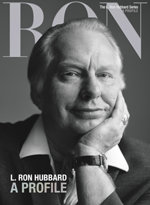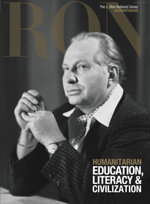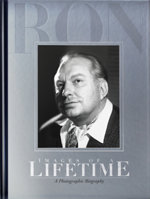Key to Life

However revelatory is L. Ron Hubbard’s Study Technology, no discussion of his educational contribution is replete without mention of his Key to Life Course. His developmental trail to Key to Life says much about both Mr. Hubbard’s approach to problems and the greater educational decline through the 1960s and 1970s.
As he rightly pointed out, three cultural factors through the latter decades of the twentieth century combined to seriously diminish our ability to communicate. First, general education standards fell as new systems ignored fundamentals of reading, writing and grammar. That decline, in turn, was hastened with the advent of television and more particularly mothers who plunked down their children in front of TVs to let a continuous inflow of images serve as both leash and baby sitter. Finally, and particularly through the 1960s, came the drug scourge to further dull the minds of a television generation. In consequence, whole generations were no longer able to comprehend or convey information. Moreover—and herein lay Mr. Hubbard’s entrance to the problem—those classes of the ’60s and ’70s were unable to utilize his earlier educational tools, simply because they lacked a comprehension of the basic structure of language itself. Needless to say, the problem has only been exacerbated with the advent of wireless communication, reducing language to monosyllabic slang. It was not for nothing, then, that Mr. Hubbard so rightly envisioned entire generations “out of communication.”
But if one truly comprehended what one read and heard and if one were to make oneself comprehended by others, all life would gloriously open. On the other hand, to the degree one cannot express oneself or make oneself understood by others, life becomes eclipsed. Such is the subject of the Key to Life Course. Step by step, it literally strips away reasons why one cannot clearly comprehend what one reads, writes and hears and why one is not comprehended by others.

“If grammar is defined as the way words are organized into speech and writings so as to convey exact thoughts, ideas and meanings among people, students will be eager to study it.
“Grammar is something people need in order to understand and to be understood and that is the end of it.”
—L. Ron Hubbard
Central to the course is a view of language, not as a random conglomeration of words arranged by grammarians, but a means to facilitate the communication of ideas. It holds words not as sacred symbols to be dissected and classified for their own sake, but as tools for use. Likewise, Mr. Hubbard presents an entirely new view of English grammar, not as a study of rules, but as the way in which words are organized so as to precisely convey thoughts and ideas amongst people.
Accordingly, his statement on the subject is aptly entitled The New Grammar. By way of background, he points out that if the man in the street has no clear concept of grammar, it is because the subject is traditionally unclear. Indeed, in the hands of grammarians, with their intricately diagramed sentences, the subject has become nothing if not authoritarian. Then, too, the subject was so wholly opinionated that he could not find a standard text that did not contradict other texts.
Thus he presented The New Grammar. It not only presents a new explanation of grammar, it also completely redefines the subject for everyday use. In that respect, Mr. Hubbard has done nothing less than take English grammar away from “authorities” and return it to everyday people. To that end, he has stripped the subject of its arbitraries, contradictions and all that simply has no point. In its place, he presents easily comprehended essentials of the language as it is used and to facilitate its use.
To that same end, he has even supplied illustrations to convey what students might normally fail to grasp with only the written word. In fact, all Key to Life materials are so illustrated, for as Mr. Hubbard reasoned: how else can one teach the meaning of a word to a student who does not understand the words used to teach him? Thus The New Grammar and other Key to Life texts define all concepts with pictures.
The result is a work that masterfully clarifies the construction of English in order to facilitate and enhance communication. As Associate Professor of Philosophy of Language at American University, Washington, DC, David Rodier, declared, “This book takes grammar and makes it easy. It helps individuals to understand the basic building blocks of the English language and how to use those building blocks to better communicate, express their thoughts and understand what they read. Only a professional writer with a writer’s sensitivity to language could have written such an innovative approach to grammar. Only such a writer would see grammar not as full of constricting rules, but full of possibilities for rich expressions of thought and action.” In that respect, he concludes, “This is a brilliant book by a brilliant mind. In fact, it is a revolution in thought.”
“This book takes grammar and makes it easy. It helps individuals to understand the basic building blocks of the English language and how to use those building blocks to better communicate, express their thoughts and understand what they read. Only a professional writer with a writer’s sensitivity to language could have written such an innovative approach to grammar. Only such a writer would see grammar not as full of constricting rules, but full of possibilities for rich expressions of thought and action. This is a brilliant book by a brilliant mind. In fact, it is a revolution in thought.”
—David Rodier, Associate Professor of Philosophy of Language, American University, Washington, DC
No less may be said for Mr. Hubbard’s second key text, Small Common Words Defined. Again, the work reflects a distillation of the language into its fundamental units. The text also reflects his critical discovery that the primary stumbling block to understanding a sentence is not the long and obscure word, but the simple words, e.g., “to,” “the,” “an.” If the point seems minor, it is not; for although one may be able to read and pronounce the sentence “good as gold,” few can actually define the word “as,” and thus lack full comprehension. To further appreciate the problem, one need only open a standard dictionary and examine the various definitions for that word. The grammarian may be satisfied, but the average reader is not—as borne out by Mr. Hubbard’s late 1970s study among college graduates who could not define even the simplest prepositions. Consequently, even common materials read for pleasure—paperback novels, for example—were not fully understood. Thus his conclusion that it was not for want of a so-called powerful vocabulary that one cannot effectively communicate; it was a failure to comprehend the building blocks upon which every larger vocabulary must rest.
What Mr. Hubbard’s Small Common Words Defined offers, then, is a full understanding of those building blocks. In all, he defines the sixty most commonly used English words, once more utilizing illustrations for easy comprehension.
“What you want in education is to teach a person how to procure, absorb, use, evolve and relay knowledge. Those would be all the steps involved, and that is what should be done if one is trying to educate somebody.”
To then enable the student to build upon that vocabulary, he additionally offers his How to Use a Dictionary. Providing concise explanations of phonetic codes, punctuation, abbreviations and more, How to Use a Dictionary resolves what most American curriculums never even bother to address: The moment one opens a dictionary, even those for children, one immediately encounters terminology and derivation symbols that are neither generally understood nor adequately explained. Consequently, the student does not even possess the primary means for comprehending language; hence, Mr. Hubbard’s solution for this problem as well.
What all these texts add up to, then, is a student who holds the veritable key to the English language—a firm grasp of how language is put together and how to most effectively use it for superior communication and better comprehension. Moreover, when taking into account the full body of Mr. Hubbard’s educational breakthroughs, one is indeed looking at a revolution in learning.




